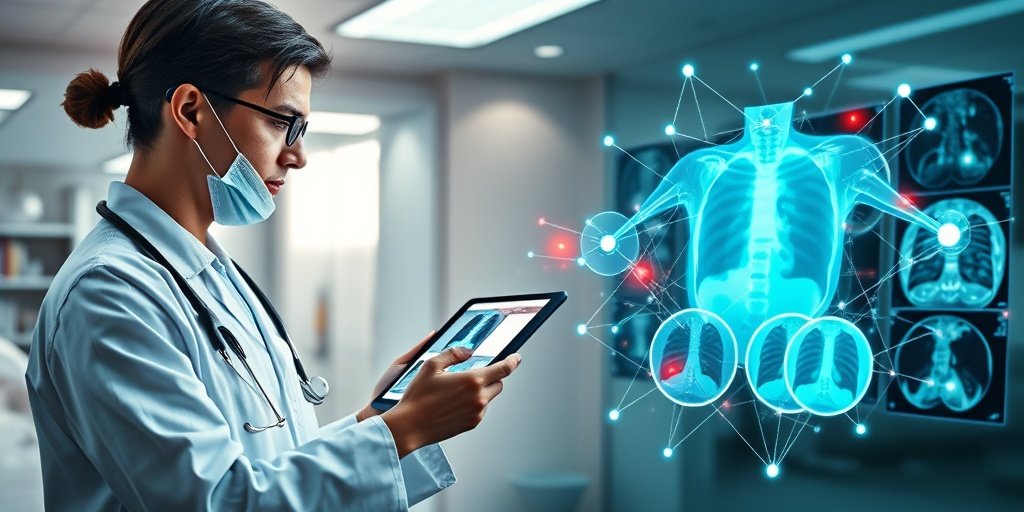⚡ Quick Summary
This study explored the use of deep learning for diagnosing COVID-19 pneumonia through medical imaging, specifically chest X-rays and CT scans. The DenseNet121 model achieved remarkable accuracy of 98%, highlighting its potential for clinical deployment in pandemic response.
🔍 Key Details
- 📊 Dataset: Medical images from chest X-ray and CT scans
- 🧩 Technologies used: VGG16, ResNet50, ConvNeXtTiny, MobileNet, NASNetMobile, DenseNet121
- ⚙️ Best-performing model: DenseNet121
- 🏆 Performance metrics: Accuracy 98%, Precision 96.9%, Recall 98.9%, F1-score 97.9%, AUC 99.8%
🔑 Key Takeaways
- 🤖 Deep learning can significantly enhance the accuracy of COVID-19 diagnostics.
- 🏥 DenseNet121 emerged as the top model for detecting COVID-19 pneumonia.
- 📈 High performance metrics indicate reliability in real-world diagnostic scenarios.
- 🌍 The study addresses critical gaps in testing, especially in resource-limited settings.
- 💡 AI-powered diagnostics can support early detection and improve pandemic response.
- 🔬 The research highlights the importance of scalable and accessible diagnostic tools.

📚 Background
The ongoing challenge posed by SARS-CoV-2 continues to affect global health, with new variants complicating diagnostics and containment efforts. Despite vaccination campaigns, the rise in global test positivity rates underscores the need for innovative diagnostic solutions. This study aims to leverage artificial intelligence to enhance the speed and accuracy of COVID-19 diagnosis through medical imaging.
🗒️ Study
Conducted by Dharmik A, this research focused on developing an automated detection system using advanced convolutional neural networks. The study evaluated multiple architectures, including VGG16, ResNet50, and others, to determine the most effective model for diagnosing COVID-19 from chest X-ray and CT images.
📈 Results
The DenseNet121 model outperformed all other architectures, achieving an impressive accuracy of 98%. The model also demonstrated a precision of 96.9%, recall of 98.9%, and an F1-score of 97.9%. The area under the curve (AUC) score of 99.8% indicates a high level of consistency and reliability, making it a strong candidate for clinical application.
🌍 Impact and Implications
The findings from this study highlight the transformative potential of AI-powered diagnostics in the fight against COVID-19. By optimizing deep learning models, healthcare systems can address significant testing gaps, particularly in areas with limited resources. The ability to quickly and accurately diagnose COVID-19 can greatly enhance public health responses and improve patient outcomes.
🔮 Conclusion
This research underscores the vital role of artificial intelligence in enhancing diagnostic capabilities for COVID-19 pneumonia. The success of the DenseNet121 model paves the way for future advancements in AI-assisted diagnostics, promising a more effective response to ongoing and emerging health crises. Continued exploration in this field is essential for improving healthcare delivery and pandemic preparedness.
💬 Your comments
What are your thoughts on the use of AI in diagnosing COVID-19? We would love to hear your insights! 💬 Share your comments below or connect with us on social media:
COVID-19 Pneumonia Diagnosis Using Medical Images: Deep Learning-Based Transfer Learning Approach.
Abstract
BACKGROUND: SARS-CoV-2, the causative agent of COVID-19, remains a global health concern due to its high transmissibility and evolving variants. Although vaccination efforts and therapeutic advancements have mitigated disease severity, emerging mutations continue to challenge diagnostics and containment strategies. As of mid-February 2025, global test positivity has risen to 11%, marking the highest level in over 6 months, despite widespread immunization efforts. Newer variants demonstrate enhanced host cell binding, increasing both infectivity and diagnostic complexity.
OBJECTIVE: This study aimed to evaluate the effectiveness of deep transfer learning in delivering a rapid, accurate, and mutation-resilient COVID-19 diagnosis from medical imaging, with a focus on scalability and accessibility.
METHODS: An automated detection system was developed using state-of-the-art convolutional neural networks, including VGG16 (Visual Geometry Group network-16 layers), ResNet50 (residual network-50 layers), ConvNeXtTiny (convolutional next-tiny), MobileNet (mobile network), NASNetMobile (neural architecture search network-mobile version), and DenseNet121 (densely connected convolutional network-121 layers), to detect COVID-19 from chest X-ray and computed tomography (CT) images.
RESULTS: Among all the models evaluated, DenseNet121 emerged as the best-performing architecture for COVID-19 diagnosis using X-ray and CT images. It achieved an impressive accuracy of 98%, with a precision of 96.9%, a recall of 98.9%, an F1-score of 97.9%, and an area under the curve score of 99.8%, indicating a high degree of consistency and reliability in detecting both positive and negative cases. The confusion matrix showed minimal false positives and false negatives, underscoring the model’s robustness in real-world diagnostic scenarios. Given its performance, DenseNet121 is a strong candidate for deployment in clinical settings and serves as a benchmark for future improvements in artificial intelligence-assisted diagnostic tools.
CONCLUSIONS: The study results underscore the potential of artificial intelligence-powered diagnostics in supporting early detection and global pandemic response. With careful optimization, deep learning models can address critical gaps in testing, particularly in settings constrained by limited resources or emerging variants.
Author: [‘Dharmik A’]
Journal: JMIRx Med
Citation: Dharmik A. COVID-19 Pneumonia Diagnosis Using Medical Images: Deep Learning-Based Transfer Learning Approach. COVID-19 Pneumonia Diagnosis Using Medical Images: Deep Learning-Based Transfer Learning Approach. 2025; 6:e75015. doi: 10.2196/75015